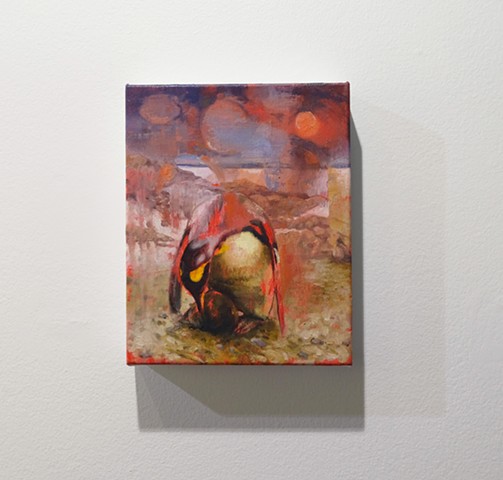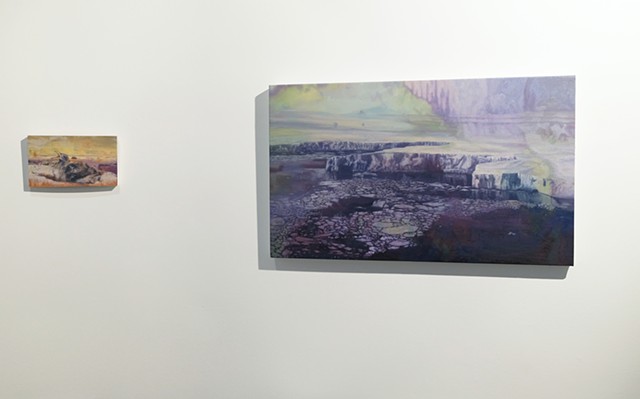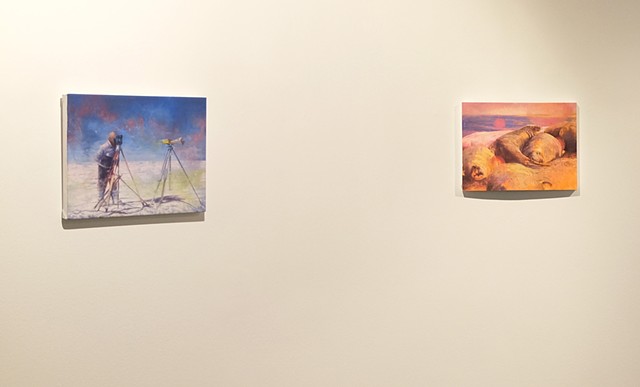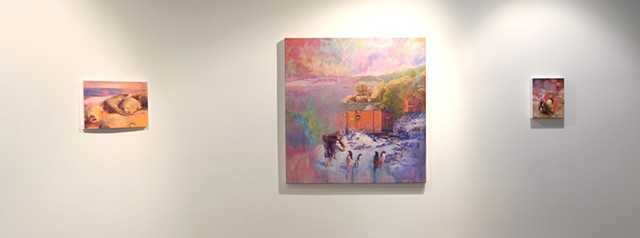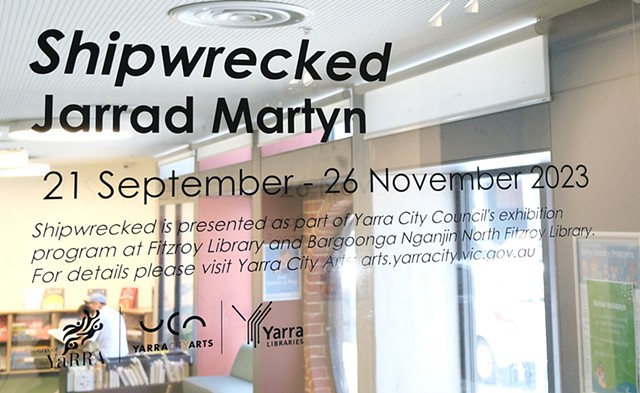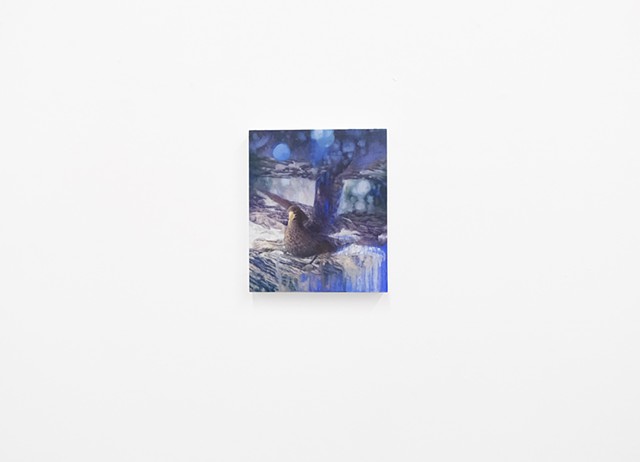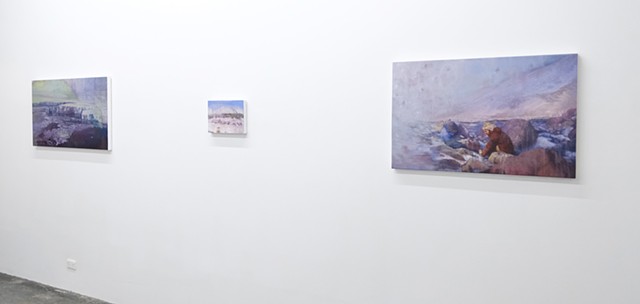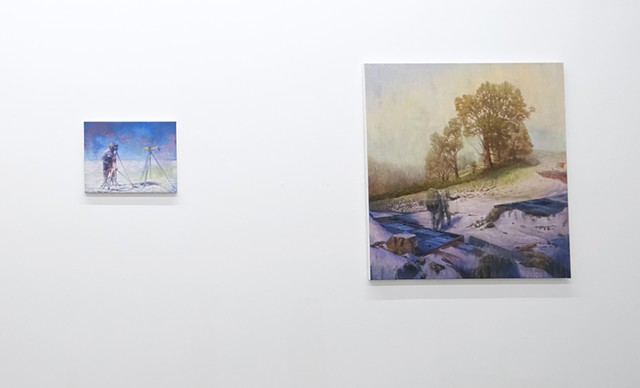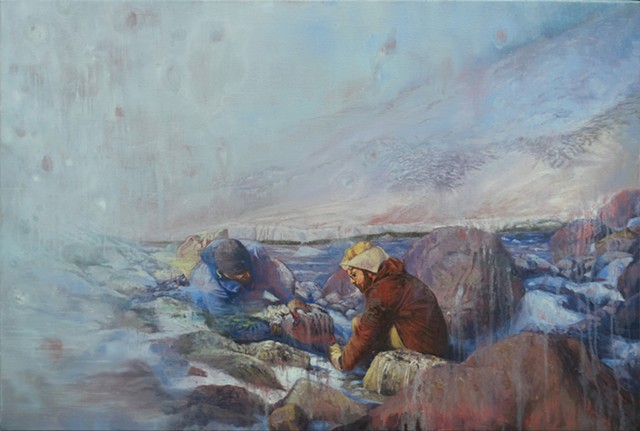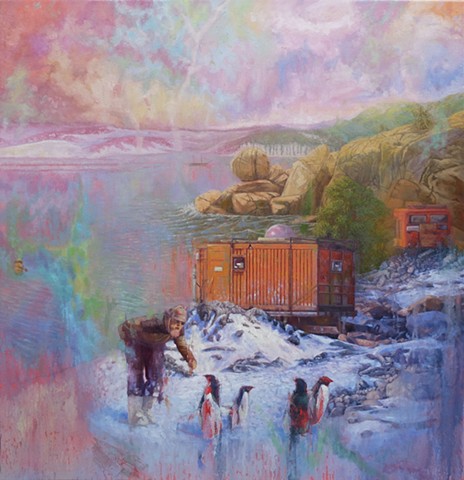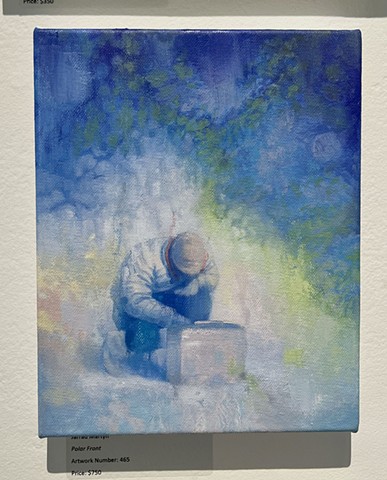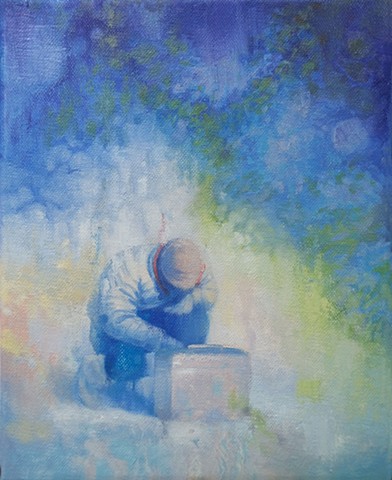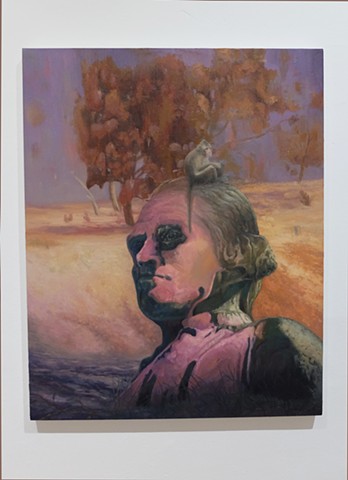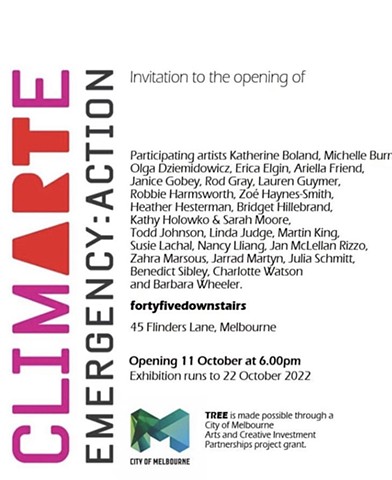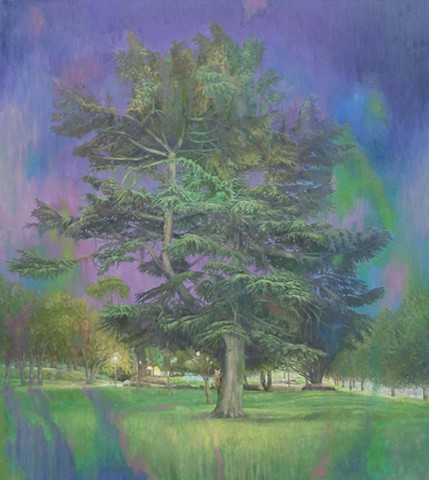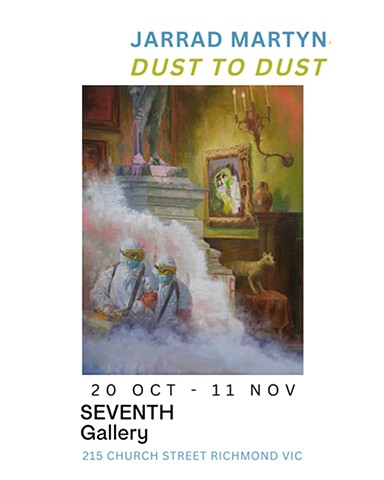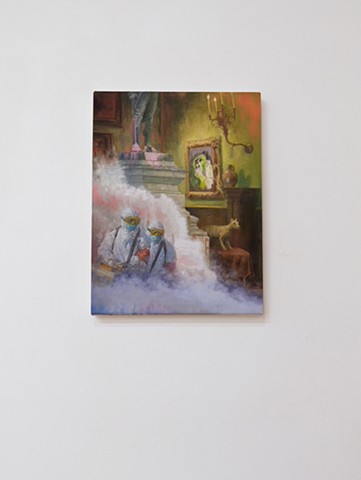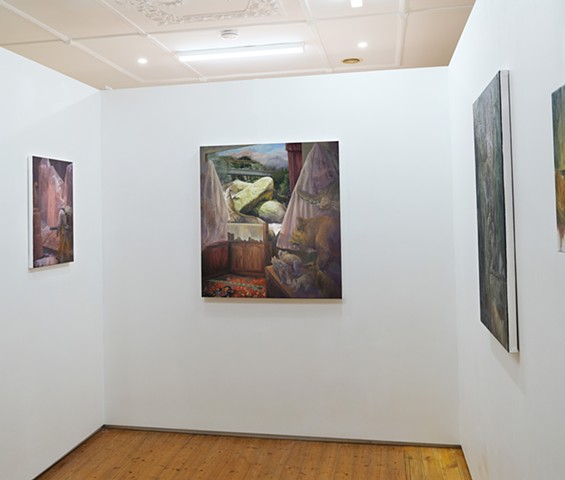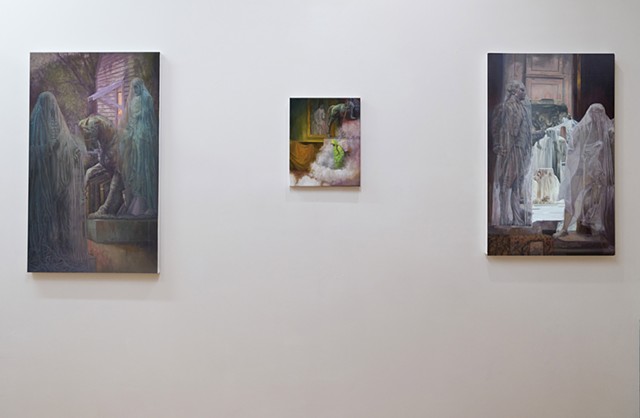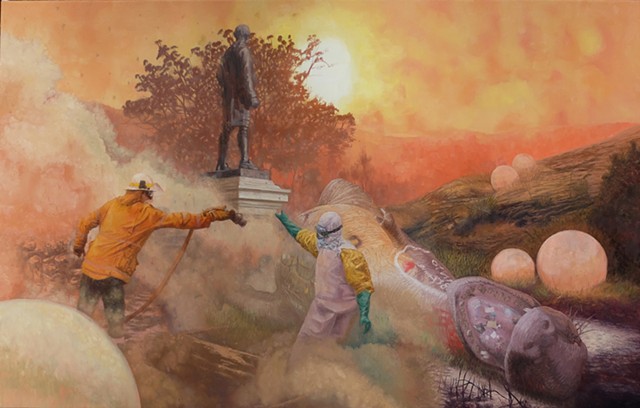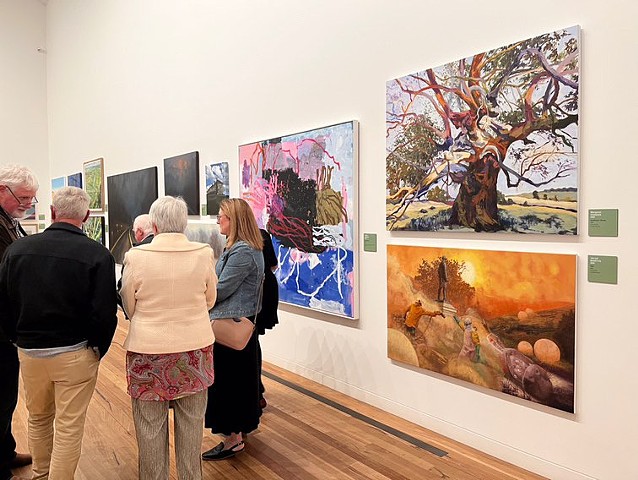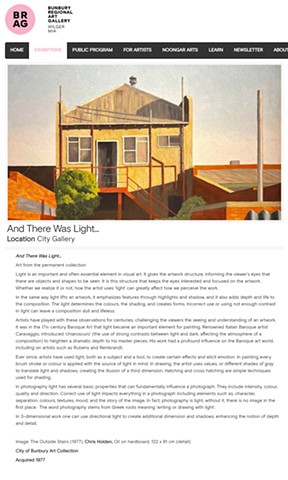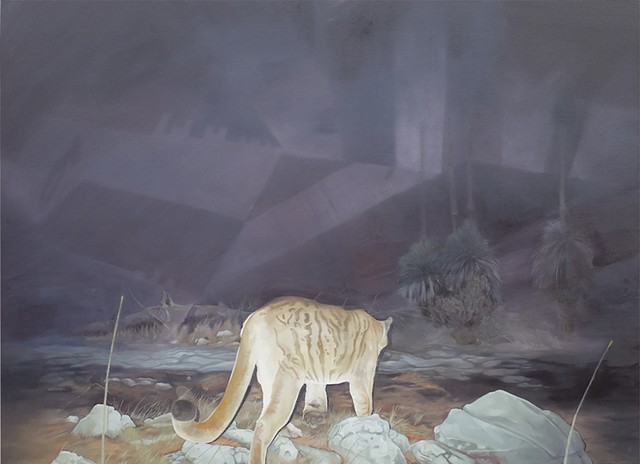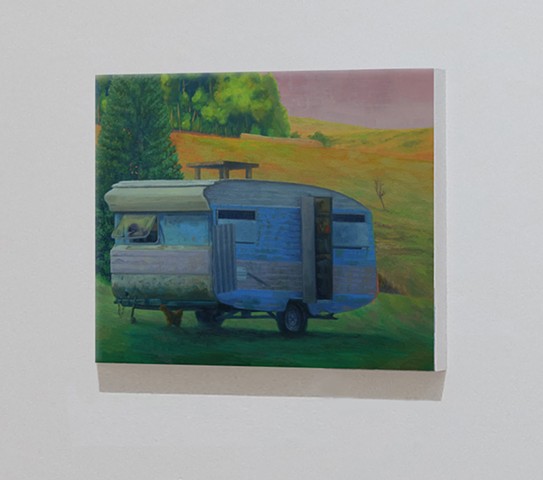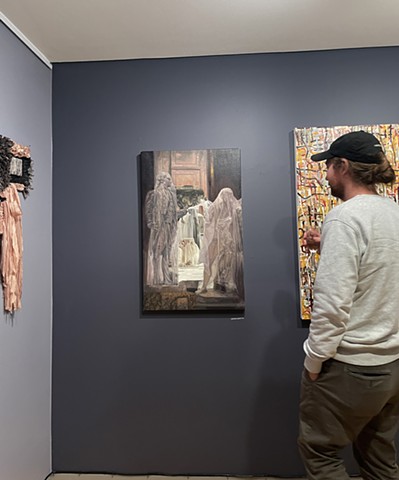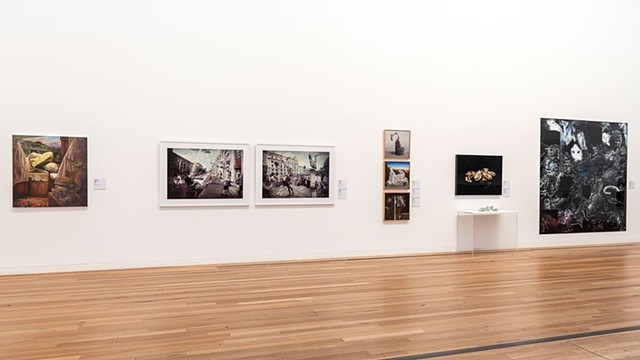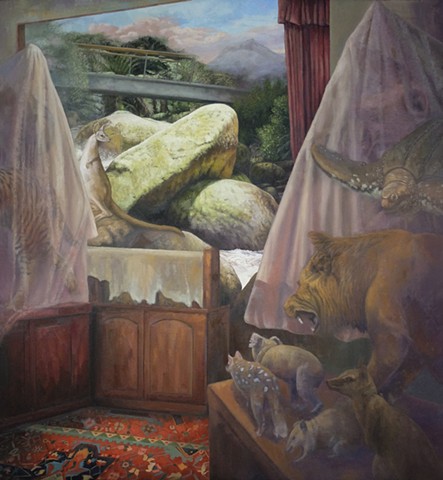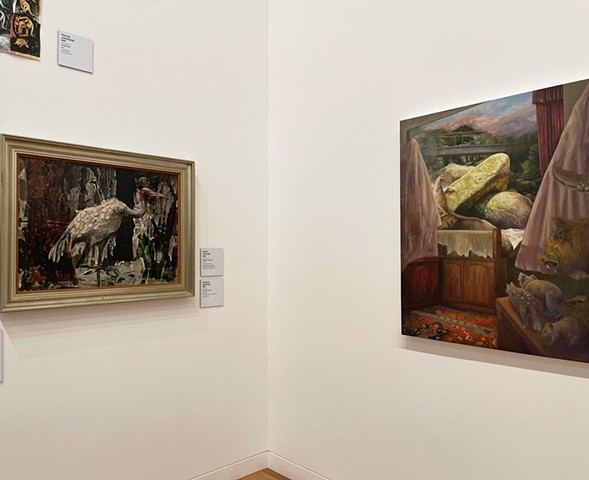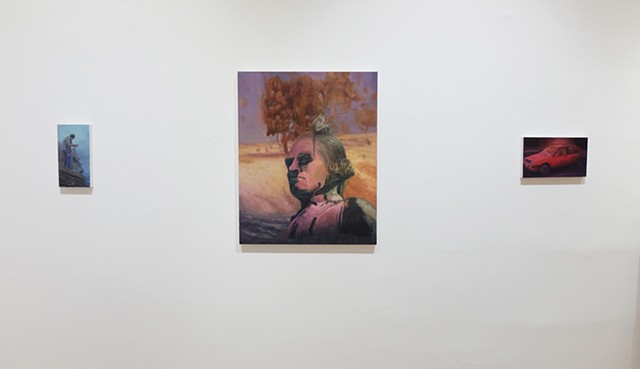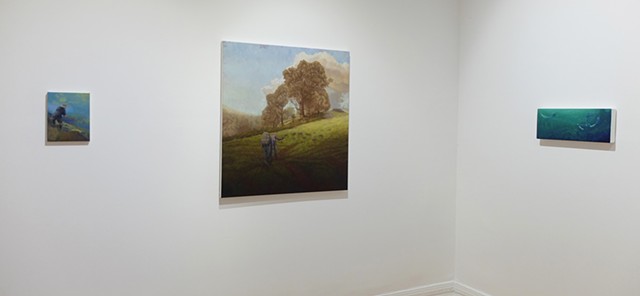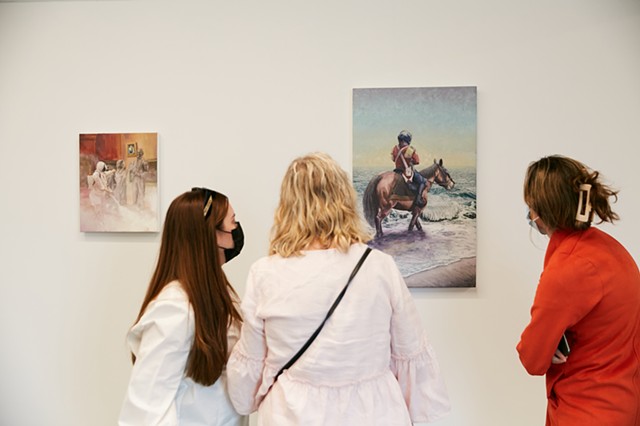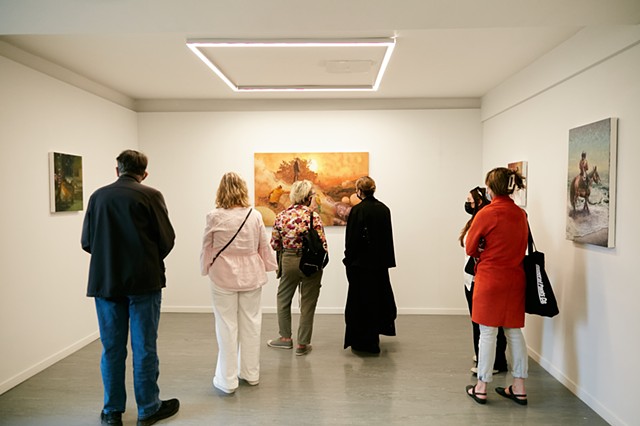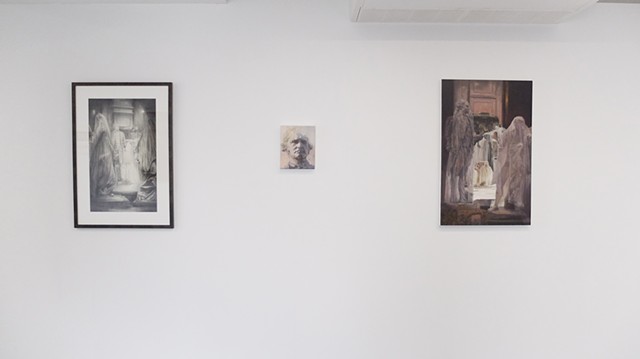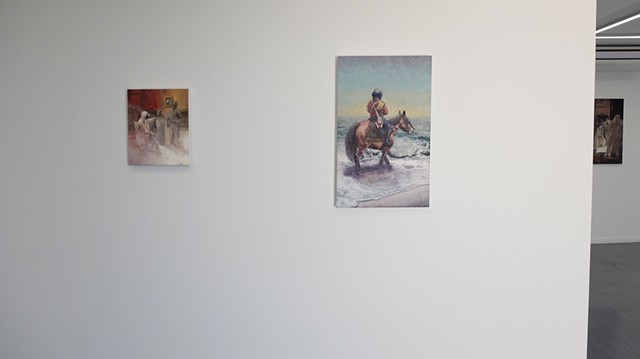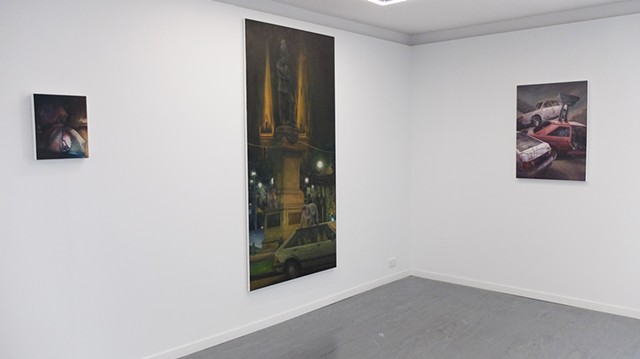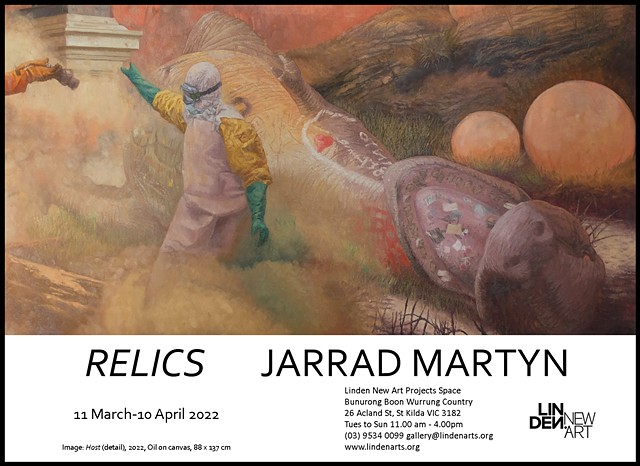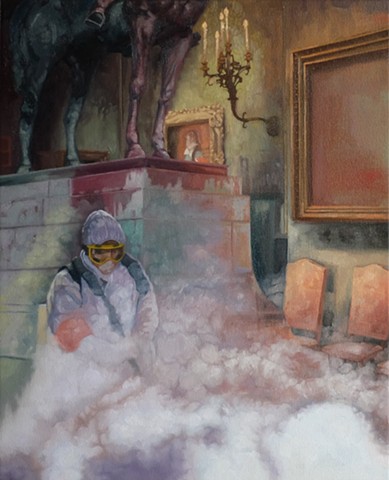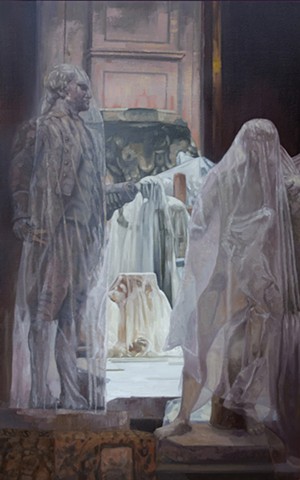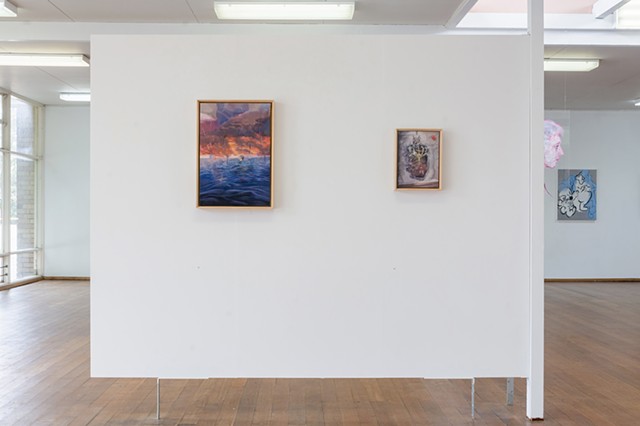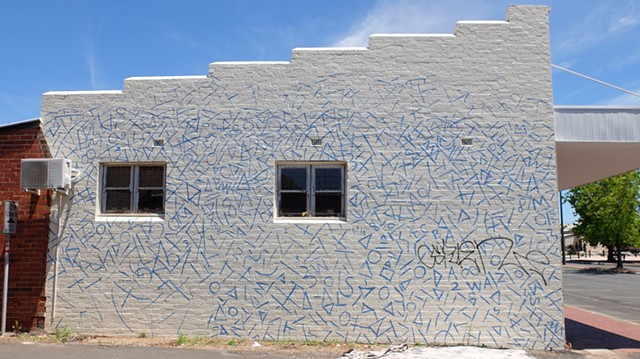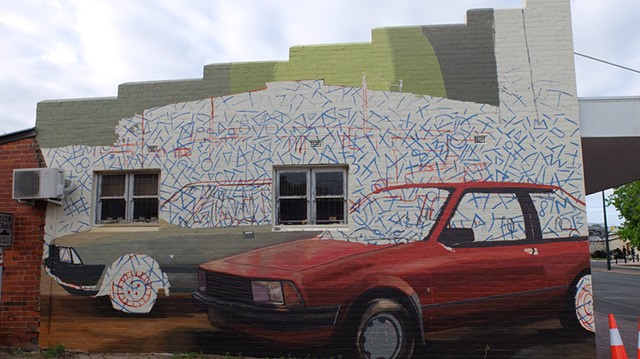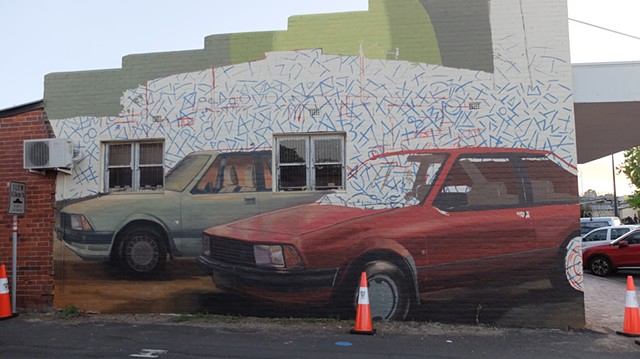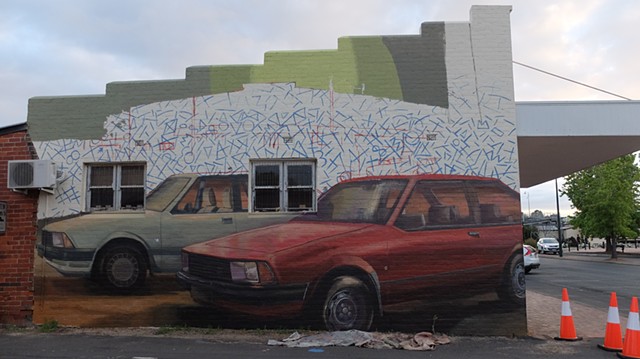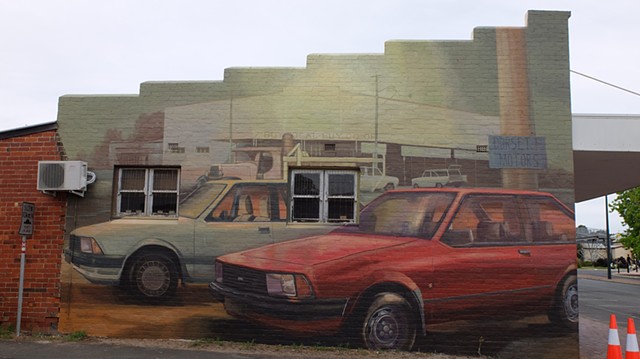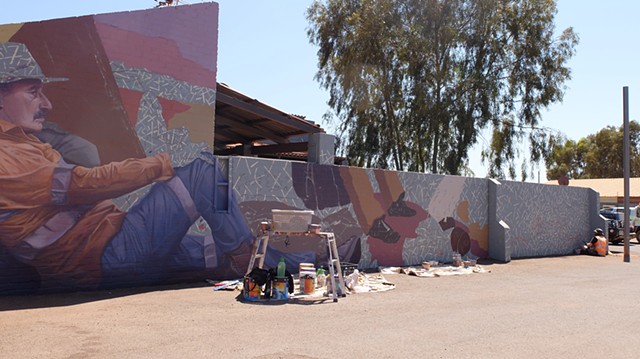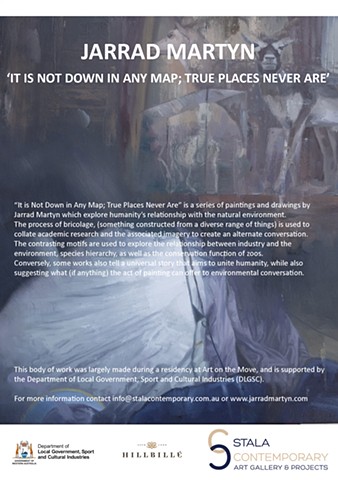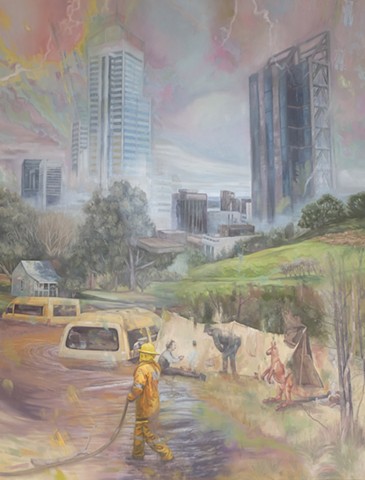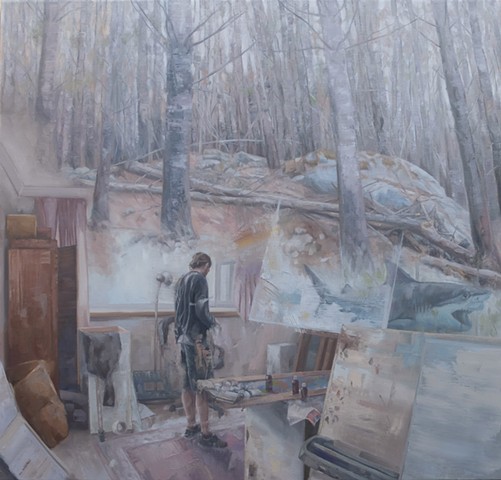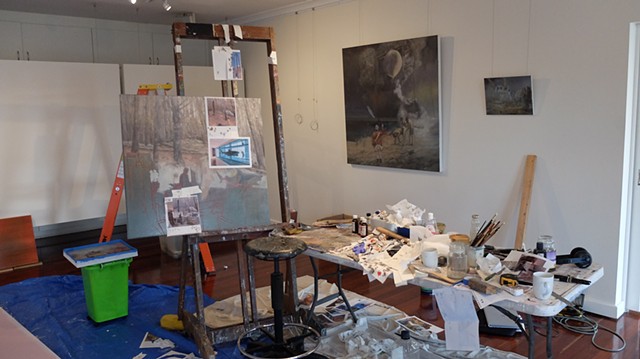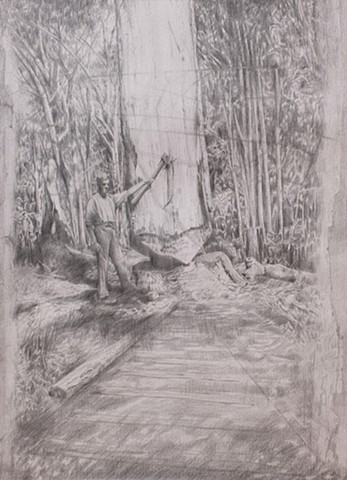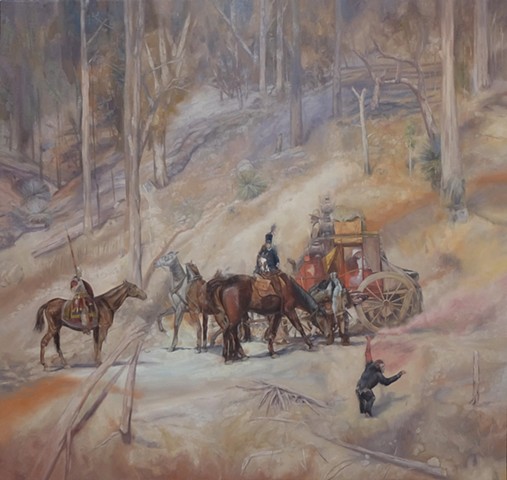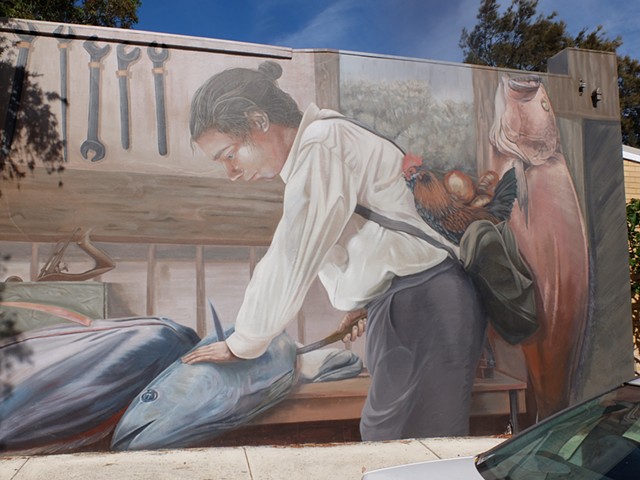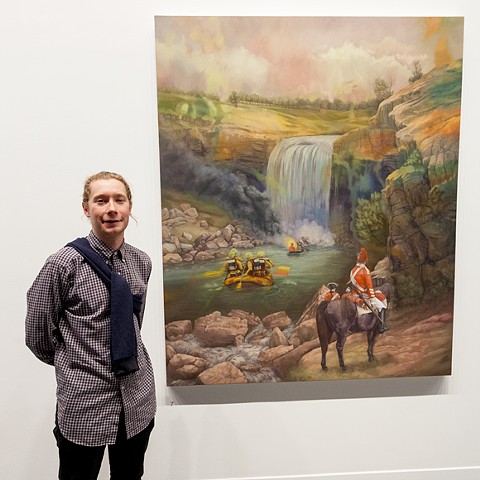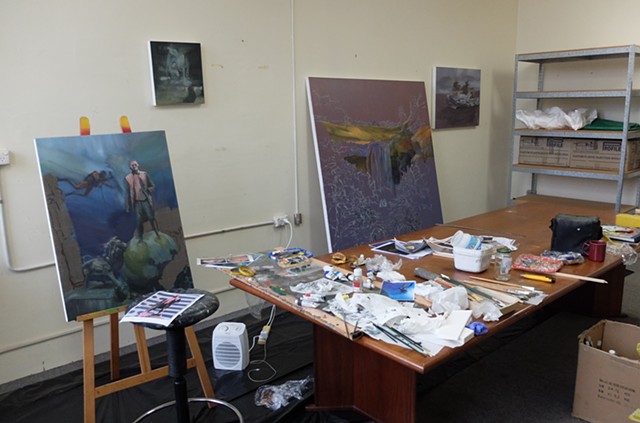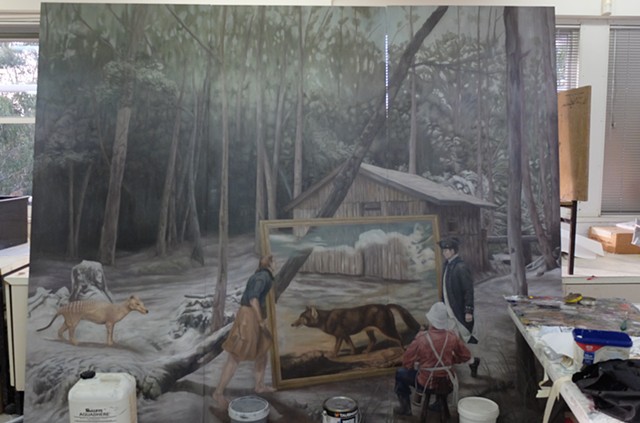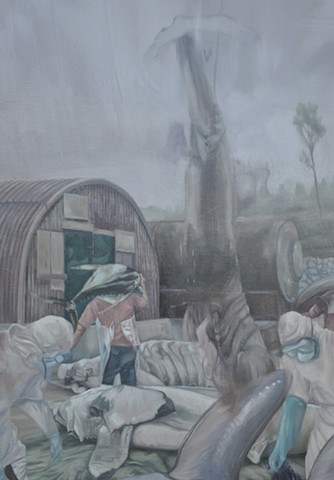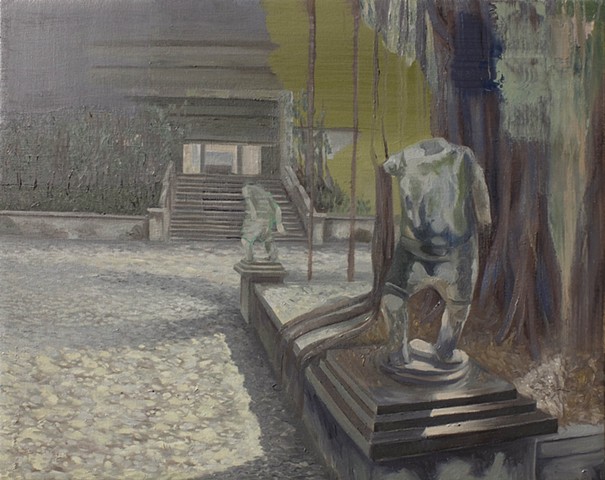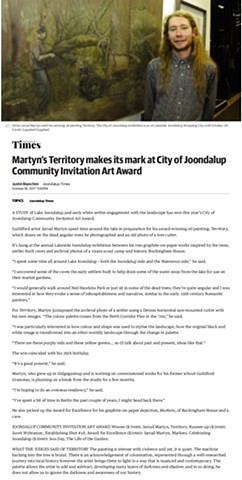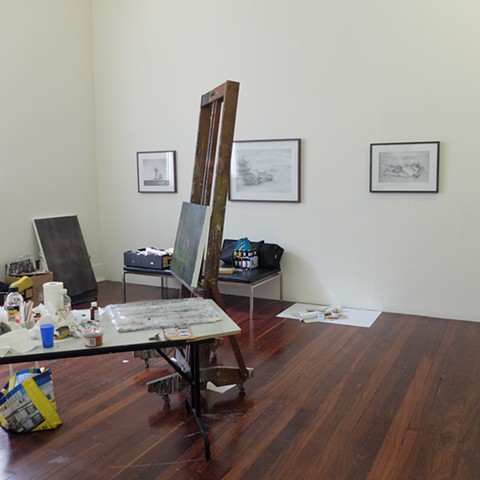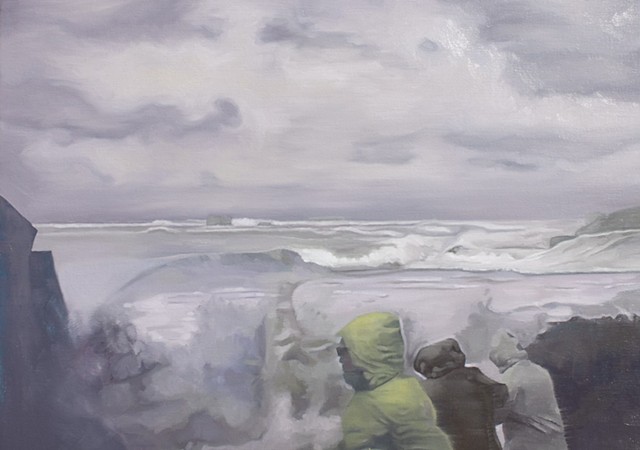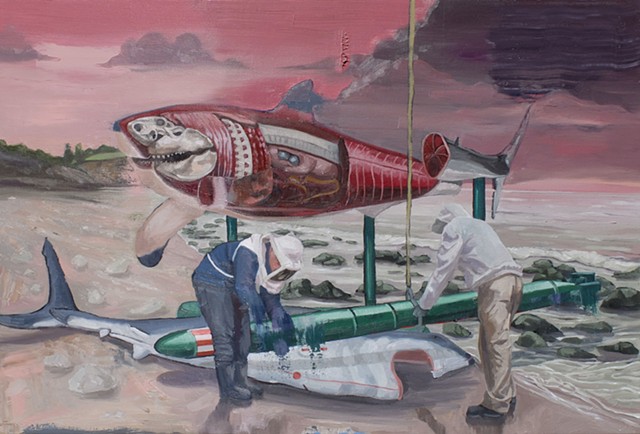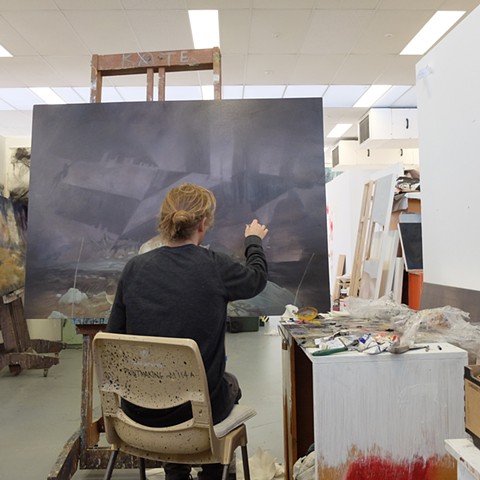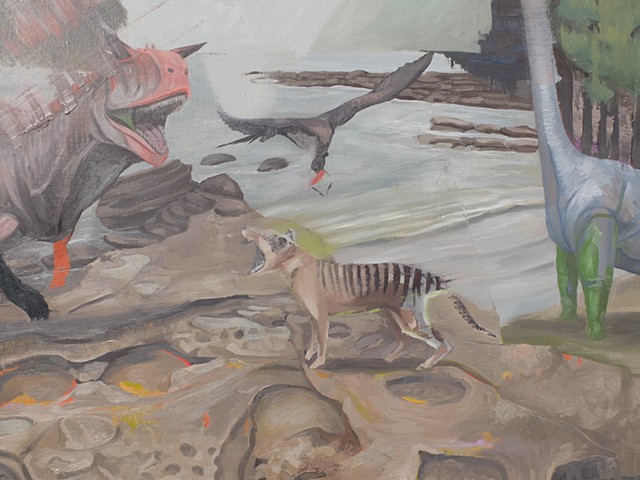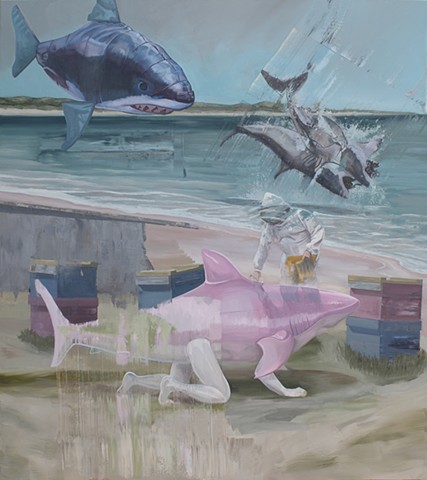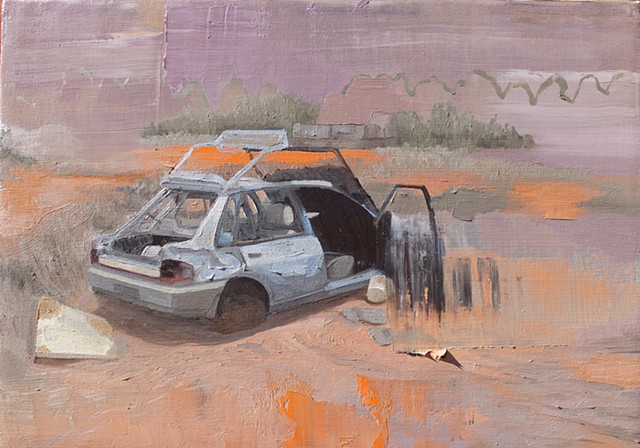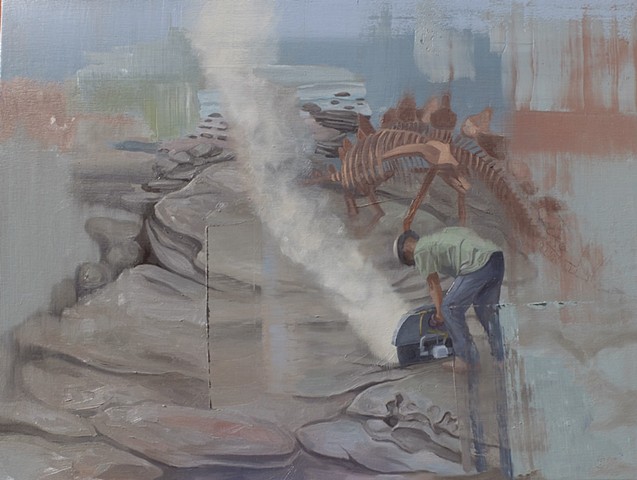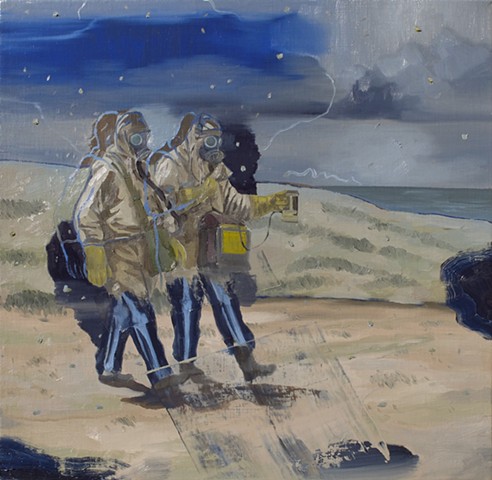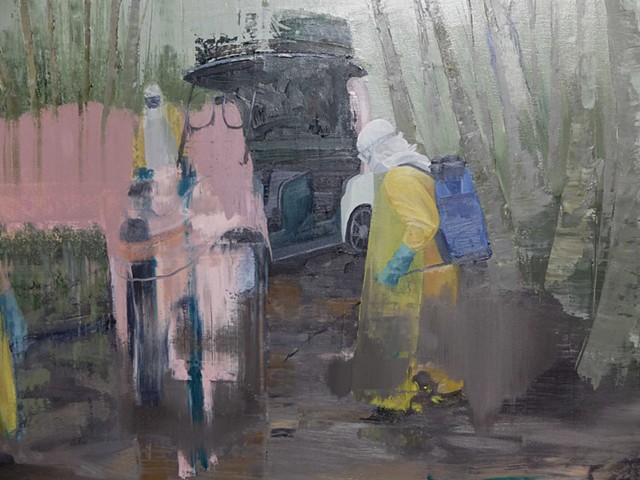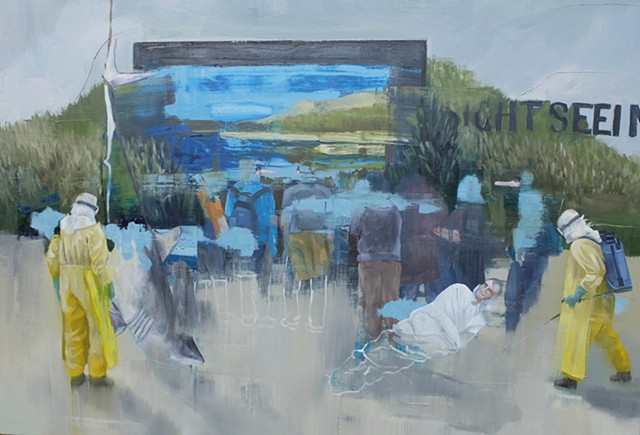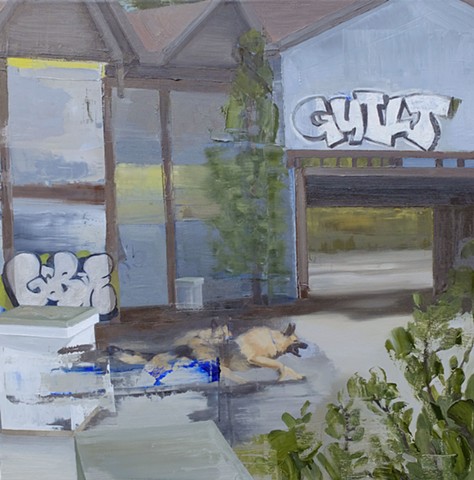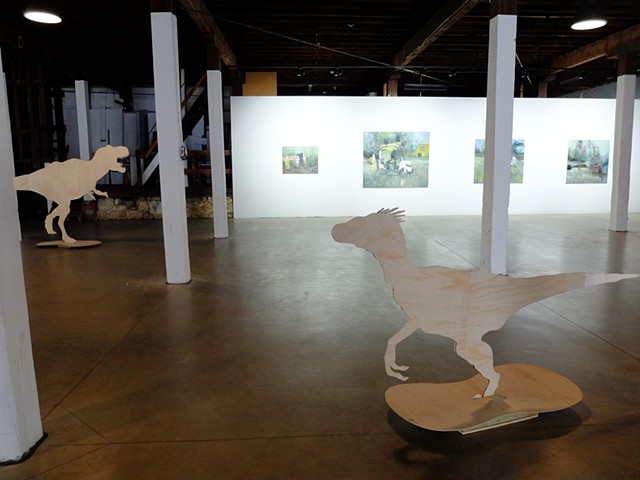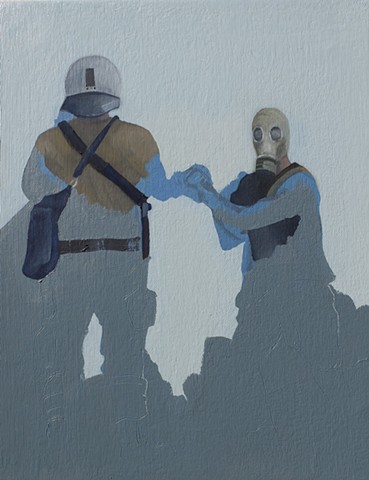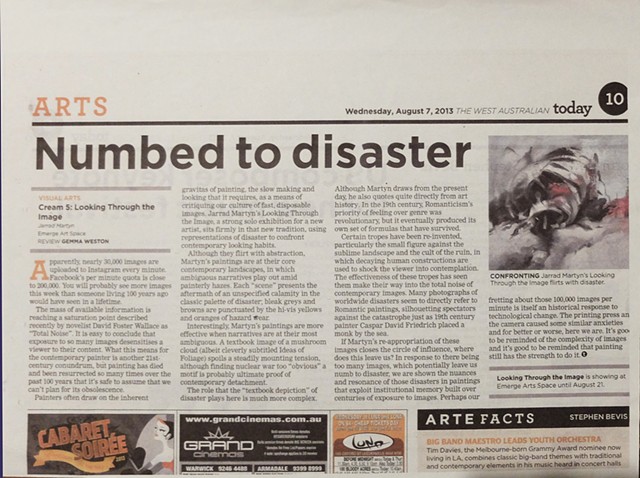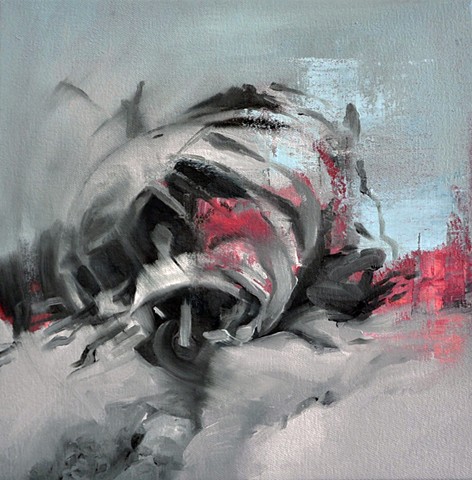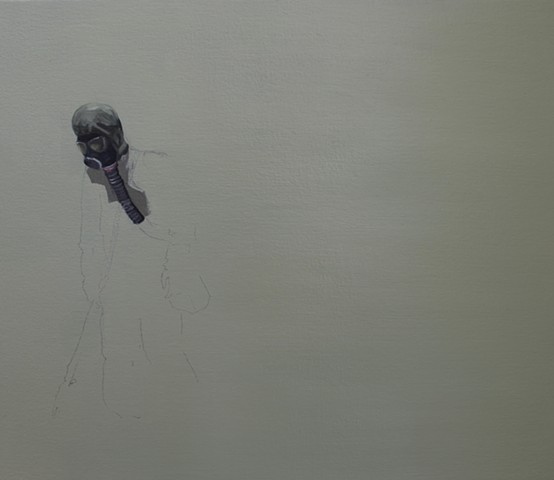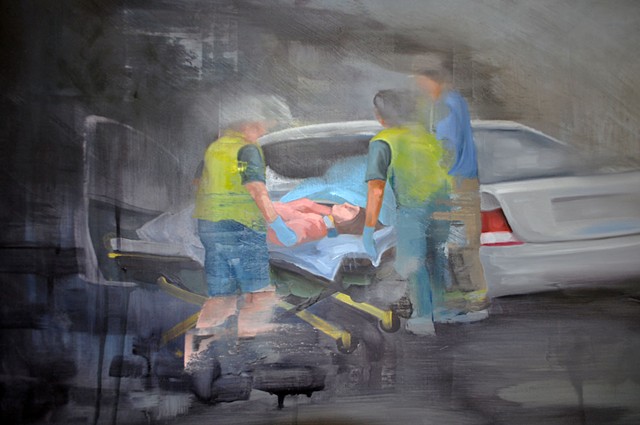2024 VCA Graduation Exhibition
Photograph by Simon Strong
2024 VCA Graduation Exhibition
Photograph by Simon Strong
2024 VCA Graduation Exhibition
Photograph by Simon Strong
2024 VCA Graduation Exhibition
Photograph by Simon Strong
2024 VCA Graduation Exhibition
Photograph by Simon Strong
2024 VCA Graduation Exhibition
Photograph by Simon Strong
2024 VCA Graduation Exhibition
Photograph by Simon Strong
2024 VCA Graduation Exhibition
Over the last two years I've been studying a Masters of Fine Arts by Research at the Victoria Collage of the Arts. The exhibition by my graduating cohort opens this Thursday 21 November, 5pm - 8.30 pm.
Exhibition runs from 22 - 28 November
Open Daily 11 am - 5 pmFinal day 28 November extended opening hours from 11 am - 9 pm.
The work explores how to use painting as a means to investigate my relationship to memory and legacy in response to a series of photographs my father took while working in Antarctica in 1985.
The work collapses the distinctions between figuration and abstraction to fracture the representation of the landscape to provide the viewer with more 'thinking time'.
My paintings will be displayed in the VCA Art Space.
Photograph by Simon Strong.
John Stringer Prize: 10 Year Retrospective at John Curtin Gallery
Endurance, 2024, oil on canvas, 160 x 149 cm
John Stringer Prize: 10 Year Retrospective at John Curtin Gallery
Now open
John Stringer Prize: 10 Year Retrospective
John Curtin Gallery, Curtin University | 25 October - 15 December
So proud to be a previous winner and invited to make three brand new work for this special show.
Also showing is Brett Whitley: In The Studio, and Aida Tomescu 'In the midst of happening'
(Left) Sojourner, 2024, oil on linen, 37 x 31 cm
(Middle) Endurance, 2024, oil on canvas, 160 x 149 cm
(Right) Curiosity, 2024, oil on linen, 31 x 41 cmJohn Leslie Art Prize at Gippsland Art Gallery, Sale
Parables & Paradoxes (Details), 2024. Oil on canvas, 146 x 135 cm.
John Leslie Art Prize at Gippsland Art Gallery, Sale
My painting Parables & Paradoxes which has been selected for the John Leslie Art Prize for landscape painting.
The exhibition runs from the 7 September - 24 November 2024.
Parables & Paradoxes, 2024. Oil on canvas, 146 x 135 cm.
The End of History at Lawerence Wilson Art Gallery
Plan (After Roberts) (Details), 2019. Oil on canvas, 135 x 145 cm
The End of History at Lawerence Wilson Art Gallery
My painting Plan (After Roberts) from the UWA art collection shown as part of The End of History exhibition at Lawerence Wilson Art Gallery. The exhibition explores artists' relationship to history, as it's made.
Plan (After Roberts), 2019. Oil on canvas, 135 x 145 cm
Including works by: Tom Alberts, Jason Auld, Claire Balley, Jane Barwell, Gordon Bennett, Mia Boe, Mandy Browne, Emma Buswell, Nicholas Compton, Rosalind Paterson Drake-Brockman, Peter Dailey, Julie Dowling, Stuart Elliott, Susan Flavell, Simon Gevers, Euan Heng, Thomas Hoareau, Marie Hobbs, Theo Koning, Jarrad Martyn, Mary Moore, Phillipa O'Brien, Michael O'Doherty, John Paul, Julian Poon, Geoff Ricardo, Jan Senbergs, Derek Tang, Jon Tarry, Imants Tillers, Paul Trinidad, Valerie Tring, Rick Vermey, Peter Wales, Jenny Watson and Yvette Watt
Curated by Gemma Weston
Iconic images are also sites for ritualising our beliefs.
Tom Roberts 1895 painting Bailed Up encapsulates our sense of Australia as a larrikin entity, lawless and dangerous. That mythologising is a platform to explore how those attitudes remain manifest in humanities disastrous impact on the natural environment, both its topography and ecosystems. Plan depicts the hold-up recorded by Roberts in 1860s Victoria but with the bushrangers replaced by characters from history, all of whom bear witness to the disastrous impact of our ongoing ecological abuse.
Creative Constellations: Atlas of Radical Hope
A close up shot of the painting I have in Creative Constellations: Atlas of Radical Hope.
Strange Attractor (Details), 2024. Oil on canvas, 84 × 80 cm
Creative Constellations: Atlas of Radical Hope
Some photos of the painting I have in Creative Constellations: Atlas of Radical Hope.
The show explores creative work that intersects climate, culture and community in ways that boldly envision a fair, socially and ecologically sustainable future based on respect and reciprocity. This exhibition is proudly held in association with the National Sustainability Festival.
120 Bridge Road, Richmond.
Strange Attractor, 2024. Oil on canvas, 84 × 80 cm
Art Basel Miami 23- Frost Museum
My work which as shown as part of 2023 Miami Art Week at the Frost Museum in collaboration with The Schmidt Ocean Institute, Nautilus Magazine and UNESCO.
Art Basel Miami 23- Frost Museum
I'm thrilled to be showing as part of Miami art week at the Frost Museum in collaboration with The Schmidt Ocean Institute, Nautilus Magazine and UNESCO.
Repost @nautilusmag • Art and ocean science meet as Nautilus teams up once again with Schmidt Ocean.
This collaboration at Art Basel Miami Beach will showcase the mesmerising works from the Schmidt Ocean Institute's Artist-at-Sea program, with exhibits spanning both Frost Science and the Miami Beach Convention Center. Continuing the tradition from our prior showcases at the Explorers Club in March 2022 and the Lisbon UN Ocean Conference in June 2022, attendees can expect breathtaking artworks inspired directly by the explorations of the Schmidt Ocean Institute's Falkor research vessel.
In partnership with UNESCO and the Phillip and Patricia Frost Museum of Science.
Install Shots of Shipwrecked at Bargoonga Nganjin/Fitzroy North Library
My exhibition in Fitzroy North at Bargoonga Nganjin recently opened. The work is part of the 2023 Yarra City Arts Program. The work continues my engagement with the family archive, with an increased emphasis on the figure-ground relationship and mark making to fracture the image than in past shows. A language of dripping, blurring and textural contrast is created to evoke an atmosphere of precariousness, shifting the representation away from the original photograph.
Install Shots of Shipwrecked at Bargoonga Nganjin/Fitzroy North Library
Install Shots of Shipwrecked at Bargoonga Nganjin/Fitzroy North Library
Install Shots of Shipwrecked at Bargoonga Nganjin/Fitzroy North Library
Install Shots of Shipwrecked at Bargoonga Nganjin/Fitzroy North Library
NotFair Art Fair
In December this year ill be showing work in Alchemy as part of the 13th edition of NotFair, an independent art fair for artists who aren't represented or whose work sits outside of the usual commercial mould. This years edition has been curated by Darren Tanny Tan and Linsey Gosper featuring 41 artists from across Australia.
Ill be presenting some new series of works at the fair.
8-13 of Dec 2023
333 Malvern Road, South Yarra
Melbournehttps://notfair.com.au/
Install Shots of Polar Front at Kyneton Stockroom
Install Shots of Polar Front at Kyneton Stockroom
Install Shots of Polar Front at Kyneton Stockroom
Polar Front at Kyneton Stockroom
Flare
2022
Oil on canvas
62 x 91 cmMy next solo show POLAR FRONT opens at Kyneton Stockroom from the 4 Feb - 12 Mar 2023.
POLAR FRONT explores humanity's relationship with the natural environment through intersecting family & world histories.
The inspiration for this new body of work comes via film photographs Martyn's Father took whilst working as a helicopter pilot, based at Casey Station in Antarctica during the 1980s.
Antarctica has experienced some of the most rapid warming on Earth, and the landscape has significantly changed since the snapshots were taken. Once-stable ice shelves are melting faster, endangered animal habitats are declining, & the human footprint in the region is increasing. In the past, the photographs were private mementos of a far-off alien land, but now are darkly prophetic.
Nillimbik Prize for Contemporary Art
I was lucky enough to be awarded the Mayor’s Award for my painting Refuge as part of the Nillumbik Prize for Contemporary Art. The works exhibited had to respond to the theme ‘Future’, Refuge continues my engagement with a series of photographs my dad took while working in Antarctica in the 1980s. I’m interested in the otherworldly feel of the images and how viewing the images forty years later evokes a sense of dread given how the climate continues to change with little action done to mitigate it. Combining early depictions of Australia with climate change data weather forecast patterns Refuge asks us to consider our future relationship to an environment which continues to change.
Congratulations to Laresa Kosloff and Tina Stefanou who won the Open and Local prize sections, we werent told in advance so it was a big surprise.
Photography by Jame Robertson, pictured is me with the Mayor of Shire of Nillumbik Ben Ramcharan.
Nillumbik Prize for Contemporary Art
Refuge
2022
Oil on canvas
89 x 91 cmMy painting Refuge has been selected for this years Nillumbik Prize for Contemporary Art.
Nillumbik Prize for Contemporary Art
My painting Refuge has been selected for this years Nillumbik Art Prize for Contempoary Art. The exhibition will be held at Montsalvat in April 2023.
Linden Postcard Show at Linden New Art
Linden Postcard Show at Linden New Art
Polar Front
2022
Oil on canvas
25 x 22 cmMy painting for this years Linden Postcard Award at Linden New Art. The work was inspired by a series of film photos my father took while working in Antarctica during the 1980s. The painting combines imagery of a blizzard with weather forecast patterns to present a landscape in flux and changing.
Merri-bek Summer Show at Moreland Gallery
My painting My Island Home is in this years The Merri-bek Summer Show at the Counihan Gallery. Each year, local artists are invited to submit an artwork that explores a chosen theme, which this year was Future Tense.
As members of communities, our relationship with statues and monuments is in a constant state of change due to the ever evolving nature of society. Recently, there has been a shift towards moral accountability and a re-examination of the achievements of memorialised figures. These iconised figures don’t reflect the ever changing diversity of Australian identity or the many stories which make up the historical narrative.
My Island Home questions how the past is remembered in the future as the collective memory of public monuments evolves in modern society. A monkey is situated on a large graffiti covered head of Captain Cook amongst a quintessential Australian landscape, partially appropriated from Tom Roberts painting She-Oak and Sunlight (1889).
By contrasting non-native fauna, the audience is encouraged to question how past representations of Australia as a British Colony no longer reflect the ever-evolving and multi-cultural identity of the modern Australian psyche.
Climarte
Climarte
Hilltop
2022
Oil on canvas
100 × 89 cmClimarte, Forty Five Downstairs, Melb VIC- 10 Oct- 22 Oct
Hilltop explores the function of trees being used as sites to support local flora and fauna.
I walk through Flagstaff Gardens multiple times each week. When I walk later at night I regularly see possums interacting with each other while navigating between the trees. Given the central location of the park and having recently moved to Melbourne, I’m often taken back at seeing large marsupials successfully living in the CBD.
Hilltop depicts a Common Brushtail Possum at the bottom of a mature Cedrus Deodar (Urban Forest Project ID 1039833) which is located in Flagstaff Gardens in West Melbourne. In Hilltop the tree is presented as being large and important, it dominates the composition, acting like a landmark. The possum is situated at the bottom of the trees trunk, dwarfed by the powerful tree.
The scene slips in between night and dusk times of day, highlighting the two different functions of the tree to the Possum, that as a home during the day and as a place it can move through at night when retrieving food. Over laid across the scene are patches of translucent saturated colours. These colour arrangements stems from the graphics used in weather forecast patterns. These patterns have been sourced from a map depicting two different weather conditions experienced in Melbourne. One of the weather forecast patterns represents the December 2019 Brushfires Heat Wave, while another reflects the yearly average of ‘expected’ weather conditions. This contrast between normal and extreme, combined with the otherworldliness created by the colour stylisation encourages the audience to consider how the climate is changing and how this effects the local flora and fauna.
DUST TO DUST at SEVENTH Gallery
My new solo show DUST TO DUST opens this week at SEVENTH Gallery in Richmond VIC.
DUST TO DUST explores the evolution of collective memory, and the function of public monuments in society. Society’s relationship with icons and monuments are in a constant state of flux. Coupled with the Black Lives Matter Movement, a increased awareness of the traditional custodians of the land, and the simultaneous COVID-19 pandemic, the moral accountability and achievements of memorialised figures, such as former colonisers and diplomats, has been questioned, and statues removed, destroyed, or in other ways contested.
Monuments reflecting Australia’s past as a British colony dot Naarm (Melbourne), these include Captain Cook, Queen Victoria, and until recently John Batman. Upon community reflection, the elevated status of these figures is being reconsidered due to the historic and continuing trauma they’ve caused, largely too First Nations people. These figures tell a very Eurocentric narrative and a fraction of the actual historical events.
My practice use the principles of bricolage, something constructed from a diverse range of things, to bring together academic research and imagery. My own photographs are collaged with historical imagery from local archives of wider Melbourne and landscapes. For example, motifs of monuments are collaged into the Melbourne Museum, the Yarra River
and other sites to create local conversations and connections. Aesthetically the handling of paint suggests the real and imagined, used symbolically to encourage dialogue around the function of memorialisation in public spaces. The works communicate that re-presenting icons away from their expected public context can educate and empower communities,
rather than continuing to bury the unpleasant facts of historical narratives that no longer serve us.The work draws on local history to encourage necessary conversations amongst the community to happen, while responding to the current movement of decolonising public spaces.
Install Shots of DUST TO DUST at SEVENTH Gallery
Install Shots of DUST TO DUST at SEVENTH Gallery
Install Shots of DUST TO DUST at SEVENTH Gallery
John Leslie Art Prize
Host
2022
Oil on Canvas
89 x 137 cmMy painting Host has been selected for this years John Leslie Art Prize at Gippsland Art Gallery in Sale, VIC.
‘Host’ responds to local history intercepting with world history; The 2019-20 Australian bushfire season, the COVID-19 Pandemic, and the questioning of public icons and monuments, fused with social justice movements are all significant world events within a short time frame. Analogous motifs are rearranged through the principles of bricolage to suggest a new ambiguous and unresolved narrative. A sense of unease is evoked by the firefighter passing the hose to the Covid marshal. This gesture echoes our own predicament - unsure about our future and our role in it, and the need for unity. Our insecurity regarding climate change, and our collective hesitance to re-examine the achievements of iconised figures. The use of paint which shifts in opacity and texture encourages the audience to look longer to try and deduce what is unfolding and to ultimately to contemplate how we frame our experience within this otherworldly landscape.
John Leslie Art Prize
Schmidt Ocean Institute
A painting I made in preparation for my residency on the Schmidt Ocean Institute research vessel RV Falkor in 2020, which ended up being cancelled because of Covid restrictions, is now in their collection.
I was really interested in the ROV ability to explore. The painting collages together imagery from past expeditions of ROV live feeds to evoke a sense of other worldliness. I was interested in the relationship between the deep ocean and space. The work features imagery from the Mariana Back-Arc expedition completed in 2016, featuring the bioluminescent Anemone. I happy to have donated the work to their collection.
And There Was Light… exhibition-BRAG
And There Was Light… exhibition-BRAG
Tawny
2018
Oil on canvas
100 x 140 cmMy painting Tawny is currently being shown at And There Was Light… exhibition until Nov 13 at Bunbury Regional Gallery, which features work from the permanent collection. The painting explores the sighting of large phantom cats in the Australian landscape. Phantom Cats are non indigenous fauna, in Bunbury there has been multiple sightings over the years. The animals were possibly released by allied forces during WW2 when it was used as a naval base. These sightings are often characterised by a sense of myth, a Bushman’s tale which continues to distort over time. The Australian landscape is littered with mysterious species which seems alien
Gosford Art Prize
Down South
2022
Oil on board
35 x 40 cmMy painting Down South has been selected for the 2022 Gosford Art Prize, Gosford Regional Gallert, NSW.
During the pandemic, I lived in both Western Australia and Victoria, where the experiences of the event were markedly different - one was marred by a forced sense of ‘normality’, and the other dealing head-on with a crisis. During the lockdowns, I found myself reminiscing, thinking about the past and looking forward into the future – ruminating on holiday snaps. Down South depicts a caravan seen on a recent holiday before relocating. The saturated palette evokes a sense of otherworldliness, encouraging associations to how much has changed in the world between the present moment and the memory of the moment.
Daydreams presents small postcard-like imagery, juxtaposed with works responding to global events. Namely, the ongoing effect of climate change and the Australian bushfire seasons, the COVID- 19 Pandemic, and the move to decolonialise public spaces. The contrast between these motifs is exaggerated by the differing scale of the works, making the viewer unsure of how they are linked. This confusion and loss of meaning reflects anxieties felt during the pandemic, and also highlights a sense of being suspended in time over the period. Martyn’s practice involves the process of bricolage, the bringing together of disparate imagery and content to develop new meanings. Daydreams continues this work, shifting the focus internally - to the artist himself, to his family and local community, and reflecting on their place in the world
Wyndham Art Prize
My painting Storage was recently selected for the 2022 Wyndham Art Prize at the Wyndham Art Gallery.
Storage, 2021. Oil on canvas, 86 x 54 cm.
Install Shots of Fragile Earth: Extinction at Gippsland Art Gallery, Sale
Left to Right- Jarrad Martyn, Michael Cook, Sam Leach, Michelle Molinari and Adam Boyd.
Image courtesy of Gippsland Art Gallery
Install Shots of Fragile Earth: Extinction at Gippsland Art Gallery, Sale
Install Shots of Fragile Earth: Extinction at Gippsland Art Gallery, Sale
I'm showing a painting as part of Fragile Earth: Extinction at Gippsland Art Gallery. The exhibition explores how climate change is affecting our life on earth. Curated by Louisa Waters and Melanie Caple.
Pictured: (L) Albert Tucker- Brolga in the Bush, 1963
(R) Jarrad Martyn- West, 2022
Install Shots of Daydreams at Brunswick Street Gallery
Install Shots of Daydreams at Brunswick Street Gallery
My second solo show in Melbourne Daydreams was at Brunswick Street Gallery in Fitzroy.Daydreams uses painting to dissect family photo albums that collective represent private histories, and the intersection of our individual experiences within a global history. The works in Daydreams convey the enormity of living through a significant historical period, and our individual and collective responses to trauma and growth.
Install Shots of 'Relics' at Linden New Art
Image courtesy of Linden New Art. Photo by Laura May Grogan.
Opening Night Shots of 'Relics' at Linden New Art
Image courtesy of Linden New Art. Photo by Laura May Grogan.
Install Shots of 'Relics' at Linden New Art
Install Shots of 'Relics' at Linden New Art
Install Shots of 'Relics' at Linden New Art
Install Shots of 'Relics' at Linden New Art
Some install photos of my exhibition 'Relics' at Linden New Art Projects Space.
Relics at Linden New Art Projects Space
Fifty Squared Art Prize
In June 2021 I won the Brunswick Street Gallery Fifty Squared Art Prize for my piece ‘Exhibit’.
Statement by Kimberley Moulton, Senior Curator South Eastern Aboriginal Collections, Museums Victoria, who judged the prize.
Brunswick Street Gallery is pleased to announce the First Prize winner as Jarrad Martyn for his painting Exhibit.Of this work, esteemed judge Kimberley Moulton said in a statement:
I was instantly taken by this painting by Jarrad Martyn titled ‘Exhibit’ both for its exquisite painterly qualities and captivating subject matter.Drawn in by the plumes of white matter into what looks like a gallery space you could be in any museum or art gallery in the world, from the NGV to the Met there is no clue to the geography of place however the universal experience of a museum and also the increasing presence of deep cleaning and people in hazmat suits are unfortunately no longer a foreign occurrence. The use of oil paint and warm colour creates a soft glow that emanates from the work, perhaps its early morning or late in the evening. Although the presumed cleaning of the gallery is taking place COVID-19 is not necessarily the subject matter here, I read themes of issues that are pertinent to our world today, health of people, the deconstruction of colonial institutions and monuments, the feelings of isolation and contemplation in a world that has dramatically changed in a short period of time. The empty frame perhaps alluding to the removal of a work, we are left to wonder why. The monument behind the human figure on the mounted horse both looks to be cast with a shadow from the dull light of the room but potentially could also be seen as splashed with red paint. Is this a deep clean for the disease of racism in these spaces or the smoking white chemical symbolic of the whitewash of history that so often permeates the art and cultural histories of institutions? There is an emptiness or a feeling of aloneness here, the empty chairs, the missing work, the figure alone and looking downwards concentrating hard at the job at task, but pushing onwards – feelings of what we have felt much of in recent times. When reading this work it inspires many questions, conceptually it is dynamic and although we may not understand the narrative from the outset, it is relatable in many ways.
Congratulations Jarrad on your work which holds a great depth of ideas and beautifully realised in your chosen medium.
– Kimberley Moulton, Senior Curator South Eastern Aboriginal Collections, Museums Victoria, who judged the prize.
https://www.brunswickstreetgallery.com.au/fifty-squared-2021-winners
‘Relics’, Linden New Art Project Space, St Kilda VIC
In May of 2021 I relocated to Melbourne, Victoria where I am busy preparing works for two solo exhibitions early in 2022. Relics at Linden New Art explores the evolution of collective memory, and the function of public monuments in modern society.
Daydreams at Brunswick Street Gallery uses painting to dissect family photo albums and my own atlas of found images. Private histories representing our individual experiences are arranged with motifs depicting events in global history. The works in Daydreams convey the enormity of living through a significant historical period, and our individual and collective responses to trauma and growth.
‘Relics’, Linden New Art Project Space, St Kilda VIC- 11th March - 11th April 2022Daydreams, Brunswick Street Gallery, Fitzroy VIC - 22nd April - 8 May 2022
Painting the Screen at Nyisztor Studio
I exhibited some works on canvas in the group show Painting the Screen, curated by Shannon McCulloch and Tanya Jaceglav at Nyisztor Studio. Photo courtesy of Tim Palman.
Collie Progress Image 1
Collie Progress Image 2
Collie Progress Image 3
Collie Progress Image 4
Collie Progress Image 5
2020
After my 2020 solo exhibition ‘Its Not Down in Any Map; True Places Never Are’, the world stopped - I was booked to do several workshops, murals, and residencies across Australia, and in Europe, which were all cancelled due to the COVID-19 pandemic. Due to these cancellations, I ended up focusing more on murals for the second half of the year, including painting walls in regional parts of Western Australia, namely Newman and Collie. The Newman project was organised by Acure Asset Management for the Newman Hotel, and the Collie project (The Collie Mural Trail) was organised by the Premier’s Department, the Shire of Collie, and SIXTWOTHREEZERO.
‘It is Not Down in Any Map; True Places Never Are', Stala Contemporary, West Perth WA
Jarrad Martyn: ‘It is not down in any map; true places never are’
Stala Contemporary 12 February - 6 March 2020
Jarrad Martyn is a painter! In his recent work, he has honed his skills to interrogate his lived experience in a world of complexity, frustration, and possibility. Whether in large-scale murals or studio paintings, Martyn involves his audience in a conversation about what it means to be an engaged participant in this world. Faced with seemingly inexplicable contradictions and a planet in crisis, he offers a place for rumination.Although he provides no easy answers or obvious solutions, he does open up a space for pondering. Embracing the words of his artistic mentor and countryman[ Jarrad Martyn was born in Aberdeen, Scotland, in 1991], Peter Doig, he adopts the stance that painting is a process inextricably linked to pondering, both as a methodology and as an objective. As a result, he slowly documents his complex thought experiments into paintings that have a long fuse, which feeds doubt, encourages conjecture, and prompts his viewers to re-evaluate their position.
Paintings have always chronicled the human condition. From the earliest ochre images applied to cave walls, they are — if any good — about ideas and how to see and how to interpret what we see. The long history of painting provides context and resonance, meshing past and present with possible futures. It is there to be mined, referenced, and evoked. It is there for the stealing, as Adrian Ghenie contends: “I steal from everybody. [ Quoted in Judd Tully, ‘How Adrian Ghenie conquered the art market The Romanian painter’s prices have increased 160-fold over the past decade. But who, or what, is behind this steep rise?’ The Art Newspaper, 22nd June 2018 09:39 GMT
]” So does Jarrad Martyn, most notably from the corpus of Australian art history. His favourite sources are Tom Roberts, Arthur Streeton, and Frederick McCubbin, but everyone is fair game.Positioning himself within history, Martyn suggests a continuity of thought that resonates across centuries. These stolen figures amble into Beautiful Mountain Alpha and look quizzically at our blundering. On Montebello Island, a Red Coat soldier tips his three-cornered hat to three local workers, wearing only shorts. They are inflating a weather balloon that will rise into the looming devastation of an atomic explosion. The mushroom cloud generated by Operation Hurricane (the first British atomic test in October 1952) morphs into Auguste Rodin’s Gates of Hell, hovering in a sulphurous sky. In a world in which Donald Trump, Hassan Rouhani and Kim Jong-un posture and threaten those gates remain wide open while we continue our menial tasks, with a nod from the past. It is a chilling image, made more so by its sublime beauty, its calm detachment, and its refusal to be didactic.
Martyn’s pondering, on what has been, what might have been, what could be, operates in a Surrealist dream-scape where time and events seamlessly fuse. His technical virtuosity facilitates that fusion, prompting our response as we enter into the reconstructed narrative of his free-flowing musings. The crisply delineated figures, the bold application of paint, the soft stains, scrapings, and impasto accretions hold our attention. Each brush mark is descriptive and expressive at the same time. In that space, we join in his reverie, struck by an awesome beauty where Rodin and the atomic cloud, British Red-coats and a 1950’s workforce, beauty and terror enmesh.
Paranoia, from 2019, brings the artist into our field of vision. In his studio — a nebulous arena invaded by the surrounding landscape — he painstakingly constructs the image we are now reading. Nannup devastated by fire looms up from the canvases arranged around the studio walls, or perhaps bleeds into them. Sidney Nolan’s Ned Kelly mask is a studio prop, along with Damien Hirst’s shark in formaldehyde The Physical Impossibility of Death in the Mind of Someone Living. The history of painting in Australia has served many nationalistic purposes, none more so that the Impressionism of Tom Roberts and Arthur Streeton and the mythologising of Sidney Nolan, but Martyn questions whether these artists have impacted on our behaviour? As Australia burns and vast tracks of land are turned to ash, devastating lives and destroying ecosystems, what role can art play? Hirst’s shark has an impact on viewers, but what of the shark? The paranoia of the artist is fed by these questions, which in turn filters into our consciousness as we engage with his painting.
Every artist, when confronted with a blank canvas, has first to establish their modus operandi. How to make a painting? What does it require, how will they embed their narrative in the process of applying pigment suspended in medium to a flat surface? For Martyn, technical proficiency is fundamental. He has a commitment to figuration, telling stories, and to embedding his practice in history and within the history of art. The surface is the entry point for the viewer, it must be seductive, but that level of seduction must be balanced with the capacity to carry his ideas; and his interests are wide. He can list countless species of turtles and varieties of coral. He is passionate about the Tesla Cybertruck and the places he has visited and intends to visit. He quotes the Leipzig School as an influence (Neo Rauch and Adrian Ghenie), and also Peter Doig and his teachers from Curtin University. He is articulate and knowledgeable; full of ideas!
Perhaps surprisingly, the process starts on his computer, in Photoshop, as he gathers images and curates threads of ideas into a bricolage of new meanings. This ‘drawing’ is then migrated to the canvas through a hand-gridding process that allows him to claim ownership and permits modification and assimilation. He juxtaposes his carefully transcribed photograph of a brace of Antelope and a cased skeleton at the Academy of Taxidermy in Guildford with a photograph of his illuminated tent from a recent camping trip to Coral Bay. Simultaneously beautiful and ominous, his stream of consciousness narrative in Watcher positions his direct experience with nature with the alienation of the museum-goer to reflect upon our relationship with the natural world. These disparate images coalesce in a magical union that underscores his peregrination.
In Collective Imagination, Martyn reflects on Yuval Noah Harari’s theory that Homo sapiens rule the world because we are the only creatures that can believe in things that exist purely in our imagination, and those universal myths of nationhood, religion, and money have led us to this current crisis in the management of our most precious resource, our planet. Within the conceptual and tactile realm of painting, myriad references can challenge, appease, confront, and coalesce simultaneously. From a magic realist flow of ideas, Martyn positions a group of scientists taking an ice-core sample — a long-term record of our impact on the earth — but he sets it within the desert and the Pinnacles north of Perth. As the Moon comes crashing into sight, the drilling rig is transmuted into a cross; of sacrifice or salvation? There are no easy answers here. Instead, the artist is framing a series of questions and pondering on how painting can contribute to the contemporary conversation around climate change.
All the works in this current exhibition are part of that wider conversation about humanity's relationship with our natural environment. Jarrad Martyn is, like Ishmael in Herman Melville’s Moby Dick, asserting that what is essential about a place is rarely found on a map. Instead, it is discovered by a deep engagement and earnest interrogation of that place, cognisant of all that has come before, all that is documented, but open to new interpretations.
It is why these very beautiful paintings are worthy of our reflection. They are a version of the contemporary sublime in which terror and beauty tip on the fulcrum of our imagination. And that is how we should approach these paintings, as a portal into knowingness, an invitation to join the artist in an open conversation about the critical issues facing us all in the first decades of the 21st century. This is not an unproblematic mission, but it is a vitally important one!
Professor Ted Snell AM CitWA
Chief Cultural Officer
Director Lawrence Wilson Art Gallery1. Jarrad Martyn was born in Aberdeen, Scotland, in 1991
2. Quoted in Judd Tully, ‘How Adrian Ghenie conquered the art market The Romanian painter’s prices have increased 160-fold over the past decade. But who, or what, is behind this steep rise?’ The Art Newspaper, 22nd June 2018 09:39 GMTCity of Perth Cultural Collections acquisition.
My painting Haze recently became apart of the City of Perth Cultural Collections.
Haze, 2019. Oil on canvas, 183 x 150 cm.
The painting Haze explores the relationship between urban and rural communities as the natural environment changes. Global warming is marked by an increase in extreme weather events - A fire-fighter attempts to hose down several flood damaged cars, as some distant figures interact over a boiling billy. The predicament facing the fire-fighter is symbolic of the current indecision and anxiety that many individuals are feeling towards climate inaction. Namely our inability to meet the targets outlined by the Paris Agreement (2015).Society is becoming much more aware of how individual daily actions affect the whole ecosystem.
The figures within the painting are artists themselves, taken from the painting The Artist Camp (1886) by Tom Roberts. By placing the camping artists within the scene, Haze questions what painting can offer to the conversation in this changing situation. It also aims to acknowledge the adaptability and sustainability of past generations - How humans have become more reliant on material possessions and technology as time has passed. This sense of insistent consumerism is reflected by the plastic blow-up Kangaroo in the foreground; nature becoming artificial in our desire for increased capital and economic growth, and the increase in disposable and single-use items.
Characteristics of the Heidelberg School of Painting, such as the isolated cottage, rolling hills, and dense foliage, have become symbolic representations of what Australians consider a rural landscape. Using source images taken from a rural property in Nannup in South West WA, these characteristics are juxtaposed against the looming skyscrapers of the Perth city Central Business District. These buildings suggest a level of control over the future of our relationship with the environment, big business, and each other. Some of the effects of these relationships will be experienced through changes in the weather, shown in Haze by sections of the sky and the wider composition being broken up by shapes and hues derived from weather forecast graphics.
St.John of God Health Care Art Collection Acquisition
My painting Paranoia was recently acquired by the St.John of God Health Care Art Collection.
Paranoia, 2020. Oil on canvas, 93 x 89 cm.
Here is what Ted Snell wrote about the work in his essay:
Paranoia, from 2019, brings the artist into our field of vision. In his studio — a nebulous arena invaded by the surrounding landscape — he painstakingly constructs the image we are now reading. Nannup devastated by fire looms up from the canvases arranged around the studio walls, or perhaps bleeds into them. Sidney Nolan’s Ned Kelly mask is a studio prop, along with Damien Hirst’s shark in formaldehyde The Physical Impossibility of Death in the Mind of Someone Living. The history of painting in Australia has served many nationalistic purposes, none more so that the Impressionism of Tom Roberts and Arthur Streeton and the mythologising of Sidney Nolan, but Martyn questions whether these artists have impacted on our behaviour? As Australia burns and vast tracks of land are turned to ash, devastating lives and destroying ecosystems, what role can art play? Hirst’s shark has an impact on viewers, but what of the shark? The paranoia of the artist is fed by these questions, which in turn filters into our consciousness as we engage with his painting.
Ted Snell, 2020
Residency at Art on the Move
Residency at Art on the Move
I was lucky enough to have a residency at Art on the Move in Fremantle, where I completed works for my upcoming solo show at Stala Contemporary.
Loveliest tints of Azure
My painting Loveliest tints of Azure recently became part of the City of Swans art collection.
Shire of Mundaring Acquisition
My drawing Land was recently acquired by the Shire of Mundaring.
University of WA Acquisition
My painting Plan was recently acquired by the University of WA (UWA).
Murals
This year I've increased the focus on murals as one of my main artistic disciplines. I've painted walls for the Town of East Fremantle, City of Vincent, City of South Perth and Shire of Dandaragan.
John Stringer Prize
I was awarded this years John Stringer Prize for my oil painting Range. Thanks to the Collectors Club of Western Australia, John Curtin Gallery, The Kerry Stokes collection and curator Kate Alida Mullen.
The oil painting Range explores the human impact on the natural environment during the anthropocene, the proposed epoch steaming from the Industrial Revolution marked by great change to the Earths geology and ecosystems.
The setting for Range is the 1866 painting of Wannon Falls in Victoria by Russian artist Nicholas Chevallier. A boat of rescue workers are paddling towards a boat of hi vi’s wearing workers situated at the base of the waterfall. The imagery is taken from Cyclone Tasha which was a primary cause of the Brisbane floods from 2010-2011. Climate changes encompasses a number of consequences including extreme weather events resulting from a rise in temperature. The marks used to depict the rescue workers are characterised by a busyness to suggest a sense of motion, in contrast to the workers ahead who appear calm and oblivious to the fire rising from the boat. Positioned between the two boats is a giant mega fauna goanna called a Megalania and two 18th century British red coat soldiers. Their placement is symbolic and acknowledges the history of global warming, which has occurred both naturally and through human impact.
The workers are about to be engulfed by the waterfall, like the Megalania which went extinct during the Pleistocene period as a result of both environmental changes and human hunting. The two solders contemplating the workers fate, reference the Industrial Revolution, which started in 1760, with the new manufacturing processes resulting from the burning of fossil fuels being the point of origin for the significant spike of CO2 levels into the atmosphere. The force of the water from the waterfall would keep the various mine and rescue workers in a state of limbo, never quite reaching each other, asking the question of how much human impact is sustainable while also acknowledging the past periods of natural warming and cooling of the landscape which have occurred during past epochs.
The patches of colour spread across the composition are derived from a weather forecast map.Combined with the blurring and softening of paint a dream like space that slips in-between real and imagined is created, encouraging the audience to understand the significant role that time plays in understanding this framing of the landscape.
Image courtesy of the John Curtin Gallery.
Midland Junction Art Centre residency
I recently completed a three month long residency at the Midland Junction Art Centre. The residency centred upon paintings and drawings which explored the human impact on the natural environment during the anthropocene, the proposed epoch steaming from the Industrial Revolution marked by great change to the Earths geology and ecosystems. Aesthetically I've being trying to increase the role of colour in my paintings, shifting away from an analogous colour scheme. The colour schemes have derived from imagery which conceptually relates to the shifting landscape resulting from global warming, such as weather chart graphics.
Guildford Grammar School Commission
I was recently commissioned by the P & C department at Guildford Grammar School to complete a large painting that responded to one of the subjects taught at the school.
Edith Cowan University Acquisition
A detail shot of my painting We're going to need a bigger boat that was recent;y acquired by ECU for their collection.
Shire of Dandaragan
My painting Turbo Theater from my 2016 solo show Abando at The Butcher Shop in Northbridge is now in the Shire of Dandaragan Art Collection.
Turbo Theater
2016
Oil on Canvas
45 x 58 cmCity of Joondalup
My drawing Markers and painting Territory won the 2017 Joondalup Community Invitation Art Award for Excellence and Overall acquisitive award.
What the judges said of Territory: The painting is intense with violence and yet, it is quiet. The machine hacking into the tree is brutal. There is an acknowledgement of colonisation, represented through a well-researched journey into local history however the artist brings these to light in a way that is nuanced and contemporary. The palette allows the artist to add and subtract, developing many layers of darkness and shadow, and in so doing, he does not allow us to ignore the darkness and awareness of our history
https://www.perthnow.com.au/community-news/joondalup-times/martyns-territory-makes-its-mark-at-city-of-joondalup-community-invitation-art-award-c-828805
City of Joondalup Community Invitation Art Award
PICA Residency
I had a six week residency at PICA in the middle of 2017, it was beneficial receiving feedback on my work from a new audience. The residency culminated in an artist talk.
Nedlands Emerge Youth Art
My painting Dazzle won the 2017 Emerge: Nedlands Youth Art Awards.
Dazzle
2017
Oil on canvas
49 x 64 cmFine Arts at Hale
My painting GWS won the 2017 Fine Art at Hale: 25th Anniversary Prize.
GWS
2017
Oil on canvas
64 x 86 cmCurtin University Residency
I had a four month residency at Curtin University earlier in the year, it was great to be making work in a communal studio environment again.
Bunbury Bienalle
My painting Tawny was acquired by the Bunbury Regional Gallery, the work was exhibited during the 2017 Bunbury Biennale.
Tawny (Details)
2017
Oil on Canvas
120 x 148 cm.Heysen prize for landscape
My painting Gantheaume Point was selected for the Heysen Prize for Landscape held at the Hahndorf Academy in South Australia.
Ghost Fishers Art Award
My work The Rare Albino Land Shark was selected for the Ghost Fishers Art Prize held at the Campbelltown Art Center in NSW from October to December 2016.
Town of Claremont Art Awards
My painting Laser received a highly commended at the 2016 Town of Claremont Art Awards.
City of Busselton Art Award
My painting Roof-Lizard received a High Commended at the 2016 City of Busselton Art Award.
Hale Art School Collection
My painting Mosaic is now in the Hale School Collection.
Mosaic, 2016. Oil on canvas. 30 x 30 cm.
Albany Art Award
My painting Klix Klex was selected for the 2015 Albany Art Award at the Vancover Arts Centre.
https://www.hugomichellgallery.com/news-exhibitions/richard-lewer-albany-art-prize-winner/
Bunbury Biennale
My painting Seeking the Umbrella was selected for the 2015 Bunbury Bienalle. The catalog for the show can be accessed here http://www.brag.org.au/component/phocadownload/category/1-bunbury-regional-art-galleries.html?download=24:bunbury-biennale-2015-catalogue
Art Angels purchase
My painting Leisure Island was purchased by the Turner Galleries Art Angels.
Tyrant Lizard King, PS Art Space, Fremantle
My second solo show Tyrant Lizard King occurred in June 2015 at PS Art Space in Fremantle. The show explored painting as a means of recounting my experience with Spreepark, a deserted theme park in Berlin. Outsiders in biohazard suits, giant swans, fallen dinosaurs and motor vehicle in the form of a giant head are used to explore the fractured experience of contemporary tourist travel and our removal of first hand experiences.
Linden Postcard Show
My painting Removal was awarded third place in the 2014 Linden Postcard show held at the Linden Centre for Contemporary Art in St Kilda, Melbourne.
http://lindenarts.org/exhibitions/the-linden-postcard-show--2014
Cream 5: Looking Through the Image Review
Here is a copy of Gemma Weston's article inthe West Australian about my solo show Cream 5: Looking Through the Image at Emerge Art Space in 2013.
Looking through the Image, Emerge Art Space
My first solo show ‘Looking through the Image’ opened on Wednesday the 24th of July 2013 at Emerge Art Space in Inglewood. The show runs until Wednesday the 23rd of August.
http://www.emerge-art.com.au/exhibitions/category/cream_5_-_jarrad_martyn
Curtin University Art Collection
My painting Ammonia is now part of the Curtin University Art Collection.
Ammonia, 2013. Oil on canvas, 36 x 42 cm.
National Campus Art Award
My painting Spectators won the 2013 National Campus Art Prize, held at Nexus Gallery in Adelaide.


















